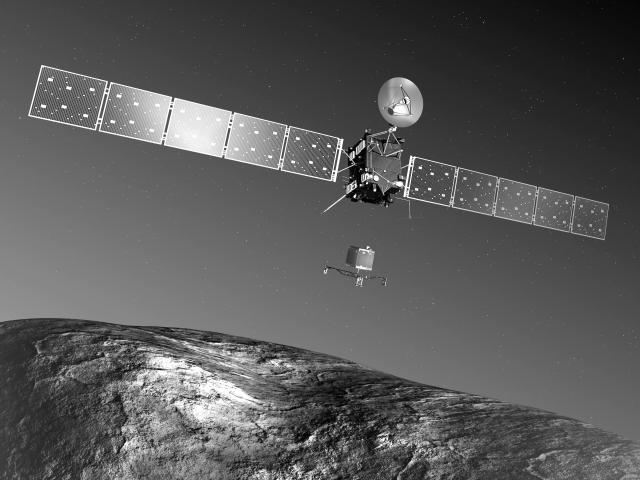Successful Rosetta Space Mission
Gallery

Ten years ago in 2004, the European Space Agency launched a fixed spacecraft named Philae, attached to its mother ship Rosetta, out into space. On Wednesday November 12th, the mechanical satellite touched down successfully onto its target, a comet called 67P—an icy, dusty piece of space debris about 130 million miles away.
While spacecraft have collided with comets in the past, this is the first unmanned, controlled, and successful landing ever.
Rosetta, the spaceship, is named after a piece of volcanic rock found in Egypt in 1799, inscribed with information that helped scientists understand ancient Egyptian culture. The lander, Philae, is named after an island in the Nile River where an obelisk was found that helped decipher the Rosetta Stone, ESA said.
The lander, Philae, was part of the ESA’s Rosetta space mission. Rosetta, the robotic space probe carrying Philae, arrived at the comet around August, taking detailed measurements before dropping Philae onto the comet while staying in its orbit.
Later after celebrating their success, the ESA admitted something unexpected had happened.
As Philae left Rosetta and landed onto 67P, instead of softly settling onto the surface of the comet as planned, the spacecraft may have bounced once or twice. Due to 67P’s weak gravity, Philae was designed with harpoons to latch onto the surface after landing. Because these harpoons failed to launch, ESA said, Philae was not firmly secure.
ESA scientists aren’t entirely sure why the slight glitch may have occurred and hope to learn more soon. However, in the meantime, they aren’t letting this get in the way of their excitement.
In an article posted on the ESA website, Jean-Jacques Dordain, the ESA’s general director said "Our ambitious Rosetta mission has secured a place in the history books: not only is it the first to rendezvous with and orbit a comet, but it is now also the first to deliver a lander to a comet's surface.”
Why is simply landing on a comet big enough news to be put into the history books?
Well, studying comets could give us more information about their composition and how exactly they interact with solar wind on the path of orbit around the Sun. Comets are some of the oldest known objects in space; studying them could give us more clues to the formation of our very universe. Studying comets could also possibly tell us more about the very beginnings of the human race and life on Earth.
At about 310 million miles from Earth and on its way around the Sun, Philae can tell us what the surface of 67P looks like as it approaches the Sun and begins to vaporize, blowing off dust and gas.
Philae also has a tool that can drill 8 inches into 67P and test this material onboard.
According to ESA project scientist Matt Taylor, Rosetta will orbit alongside the comet, allowing it to witness the effects of heat and vaporization as it gets nearer to the Sun. It could get as close as about 112 million miles from the Sun, he said.
A few days later, in a slightly awry turn of events, Philae’s batteries ran out and it shut down. Due to the bouncing during the landing, Philae actually landed near a cliff on 67P’s surface rather than the originally planned surface which was flat. In turn, this caused Philae to be immersed in shadow.
For a satellite running on solar power, it was bad news for the ESA, who lost contact with the lander after it went into ‘idle mode’ only a three days after landing.
Fortunately, Philae was able to fulfill its original mission using its own battery charge, said lander system engineer Laurence O'Rourke. Also, he says, it’s a stroke of luck Philae landed in the shadows; there’s a possibility it may be able to come back to life without the risk of its batteries being burned out fairly quickly- which is what would have happened had Philae landed correctly.
Before Philae completely shut down, mission controllers were able to send commands, rotating the main body and its attached solar panels, which may expose it to just enough sunlight to start up Philae’s battery.
"The lander has the ability of keeping itself warm but doesn't have the capability to cool itself down," O'Rourke told CNN in a recent article.
While Philae’s future is uncertain, the mother ship Rosetta will continue to follow the comet on its trip through space regardless; and with names as legendary as Rosetta and Philae, expectations are definitely high for the outcome of this space mission.
